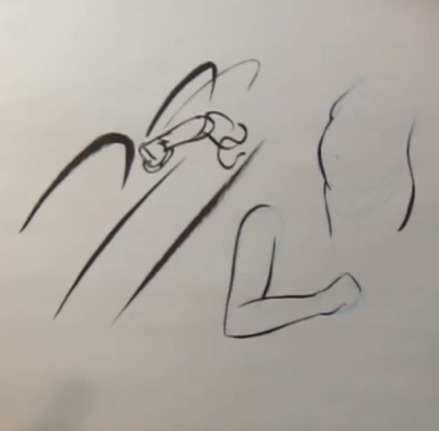If I understood the problem well, I would say above examples are using "the rule" of line weight.
It took me some time to find these videos. Since I am not an expert on this subject, I thought letting professionals explain it was much better idea. I have been given advice to try an summarize the content of the video. I somehow find it unfair towards artist. However, I will try to add more details by using the knowledge I have. However, consider watching these videos done by artists who are really experienced in that field:
- how to think about line weight video.
- Line Weight (CtrlPaint.com)
and
- Line Weight: when to vary it and why?.
What is line weight and what can it do?
To simplify, line weight is the weight you put on your pencil while drawing and thus producing darker or lighter lines.
To be precise:
Weight refers to the strength, heaviness, or darkness of a line
against the background. It can be achieved through different
thicknesses, intensities, and sometimes even different patterns -
dashes, dots etc. Traditionally, you would generate a heavier line by
applying more pressure, or by angling the pencil to produce a thicker
line. Today, you can find pens with different nib sizes, and pencils
and leads with different hardness to aid the process of producing
different line weights.
To indicate closer objects, overlapping edges or stronger parts of an objects as well as curves where the shadow would fall, thicker line is used.
To indicate objects in the distance, edges of the objects behind other objects or to draw parts where a light would fall, thinner line is used.

To analyze this drawing lets take a look at thicker lines.
Thicker the line, more weight it has. Following what I stated above, I have concluded that light, on this particular drawing, comes from upper right corner.
First thick line is on his right arm, exactly where your arrow is pointing. It is under the arm, which means an indication of shadow.
Another is on his back, precisely under your left arrow. That means, shadow is falling on his left side. If you inspect drawing more, you will see that most of thick lines are on the left side or "under" his clothing.
The line under his coat is also thick, which indicates that his coat, or jacket, has been lifted as he is trying to throw the bowling ball.
One big hint to this is the shadow artist drew on the left leg of this character. Where the darkest areas are, artist drew couple of parallel lines to indicate it.
We can do the same by following lighter (thinner) lines.
Lets take a look at the area where you left arrow is pointing.
It is indicating curvature. Obviously, our character has "stronger back". However, that particular part of the line is lighter because the light is hitting that part of the character's body.
Applying this reasoning to other parts of the same drawing (or other drawings) will show the pattern which will become easily recognized further on.

Now, these sketches are using the exact same rule. I am not sure is the "rule" right word to use. Maybe approach, principle or technique would suit it better.
Look at lighter lines: that is where the light is hitting the object. You will see, that on the opposite side heavier line is drawn. This does not always have to be this way. It all depends on how many light sources you have, what object your are trying to represent and so on.
However, the pattern is there.
Lets summarize it with some examples
So, by varying the weight of the line we can indicate:
Curvatures (but also pointy things!)
Shadows and light
Distance - adds depths, adds more dimension to the drawing.
Example 1:


To add stronger muscle, artist is using heavier line. That makes perfect sense if we think about it in this way: If a person is standing in such a way that light is hitting them from the right side, left side of that person's body will be more dark. The further the body part from the light is, the darker it gets. So, if we want to draw someone who has huge muscles, or any curves to generalize it, the bigger the curve is, further away from the light source is positioned which means it is darker. On the other side, if curvature is being hit by the light, bigger the curvature, lighter the line is, because, now, our body part is getting closer to that light.
In real life this can be seen. The more we lit one side of the object, the lines of that side are becoming more or less noticeable (depending on the background)because of the reflection of that light.

Image taken from www.researchgate.net.
Example 2:

Heavier line is on the side where shadow is cast. Lighter line is on the side where light is hitting the surface/arm.
Example 3:

Further away, lines get lighter.
These steps are applied in the drawings you posted.
However, these steps do not have to be followed precisely. Sometimes, you can just vary the weight of the line and get nice results.
P.S. Screenshots are taken from videos I posted above.
 [ Image: from Cartooning Self-Taught by Bill Nolan, via the Internet Archive. ]
[ Image: from Cartooning Self-Taught by Bill Nolan, via the Internet Archive. ]







